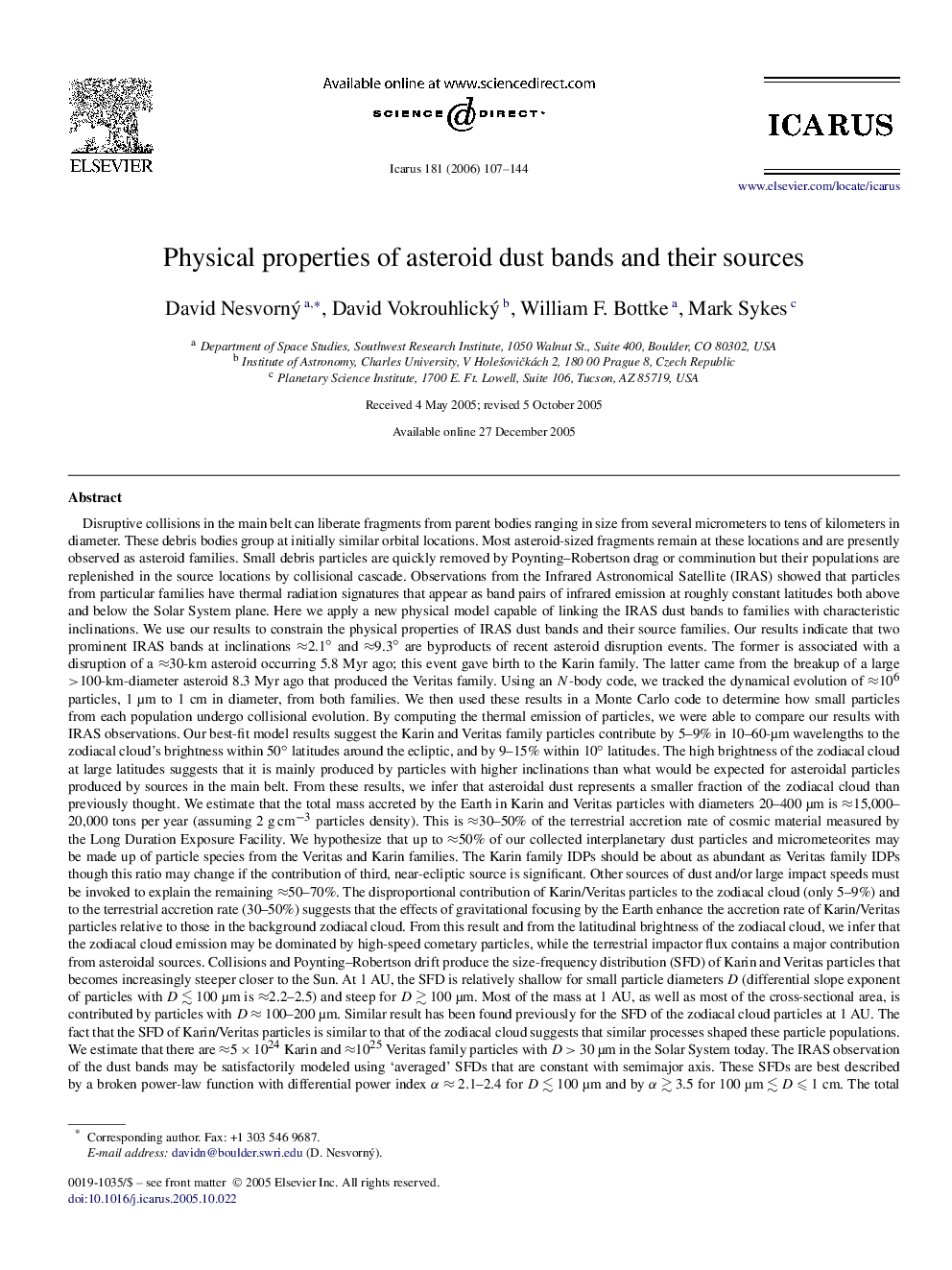| Article ID | Journal | Published Year | Pages | File Type |
|---|---|---|---|---|
| 1775881 | Icarus | 2006 | 38 Pages |
Disruptive collisions in the main belt can liberate fragments from parent bodies ranging in size from several micrometers to tens of kilometers in diameter. These debris bodies group at initially similar orbital locations. Most asteroid-sized fragments remain at these locations and are presently observed as asteroid families. Small debris particles are quickly removed by Poynting–Robertson drag or comminution but their populations are replenished in the source locations by collisional cascade. Observations from the Infrared Astronomical Satellite (IRAS) showed that particles from particular families have thermal radiation signatures that appear as band pairs of infrared emission at roughly constant latitudes both above and below the Solar System plane. Here we apply a new physical model capable of linking the IRAS dust bands to families with characteristic inclinations. We use our results to constrain the physical properties of IRAS dust bands and their source families. Our results indicate that two prominent IRAS bands at inclinations ≈2.1° and ≈9.3° are byproducts of recent asteroid disruption events. The former is associated with a disruption of a ≈30-km asteroid occurring 5.8 Myr ago; this event gave birth to the Karin family. The latter came from the breakup of a large >100-km-diameter asteroid 8.3 Myr ago that produced the Veritas family. Using an N-body code, we tracked the dynamical evolution of ≈106 particles, 1 μm to 1 cm in diameter, from both families. We then used these results in a Monte Carlo code to determine how small particles from each population undergo collisional evolution. By computing the thermal emission of particles, we were able to compare our results with IRAS observations. Our best-fit model results suggest the Karin and Veritas family particles contribute by 5–9% in 10–60-μm wavelengths to the zodiacal cloud's brightness within 50° latitudes around the ecliptic, and by 9–15% within 10° latitudes. The high brightness of the zodiacal cloud at large latitudes suggests that it is mainly produced by particles with higher inclinations than what would be expected for asteroidal particles produced by sources in the main belt. From these results, we infer that asteroidal dust represents a smaller fraction of the zodiacal cloud than previously thought. We estimate that the total mass accreted by the Earth in Karin and Veritas particles with diameters 20–400 μm is ≈15,000–20,000 tons per year (assuming 2 g cm−3 particles density). This is ≈30–50% of the terrestrial accretion rate of cosmic material measured by the Long Duration Exposure Facility. We hypothesize that up to ≈50% of our collected interplanetary dust particles and micrometeorites may be made up of particle species from the Veritas and Karin families. The Karin family IDPs should be about as abundant as Veritas family IDPs though this ratio may change if the contribution of third, near-ecliptic source is significant. Other sources of dust and/or large impact speeds must be invoked to explain the remaining ≈50–70%. The disproportional contribution of Karin/Veritas particles to the zodiacal cloud (only 5–9%) and to the terrestrial accretion rate (30–50%) suggests that the effects of gravitational focusing by the Earth enhance the accretion rate of Karin/Veritas particles relative to those in the background zodiacal cloud. From this result and from the latitudinal brightness of the zodiacal cloud, we infer that the zodiacal cloud emission may be dominated by high-speed cometary particles, while the terrestrial impactor flux contains a major contribution from asteroidal sources. Collisions and Poynting–Robertson drift produce the size-frequency distribution (SFD) of Karin and Veritas particles that becomes increasingly steeper closer to the Sun. At 1 AU, the SFD is relatively shallow for small particle diameters D (differential slope exponent of particles with D≲100 μmD≲100 μm is ≈2.2–2.5) and steep for D≳100 μmD≳100 μm. Most of the mass at 1 AU, as well as most of the cross-sectional area, is contributed by particles with D≈100–200 μmD≈100–200 μm. Similar result has been found previously for the SFD of the zodiacal cloud particles at 1 AU. The fact that the SFD of Karin/Veritas particles is similar to that of the zodiacal cloud suggests that similar processes shaped these particle populations. We estimate that there are ≈5×1024≈5×1024 Karin and ≈1025 Veritas family particles with D>30 μmD>30 μm in the Solar System today. The IRAS observation of the dust bands may be satisfactorily modeled using ‘averaged’ SFDs that are constant with semimajor axis. These SFDs are best described by a broken power-law function with differential power index α≈2.1–2.4α≈2.1–2.4 for D≲100 μmD≲100 μm and by α≳3.5α≳3.5 for 100 μm≲D⩽1 cm100 μm≲D⩽1 cm. The total cross-sectional surface area of Veritas particles is a factor of ≈2 larger than the surface area of the particles producing the inner dust bands. The total volumes in Karin and Veritas family particles with 1 μm
